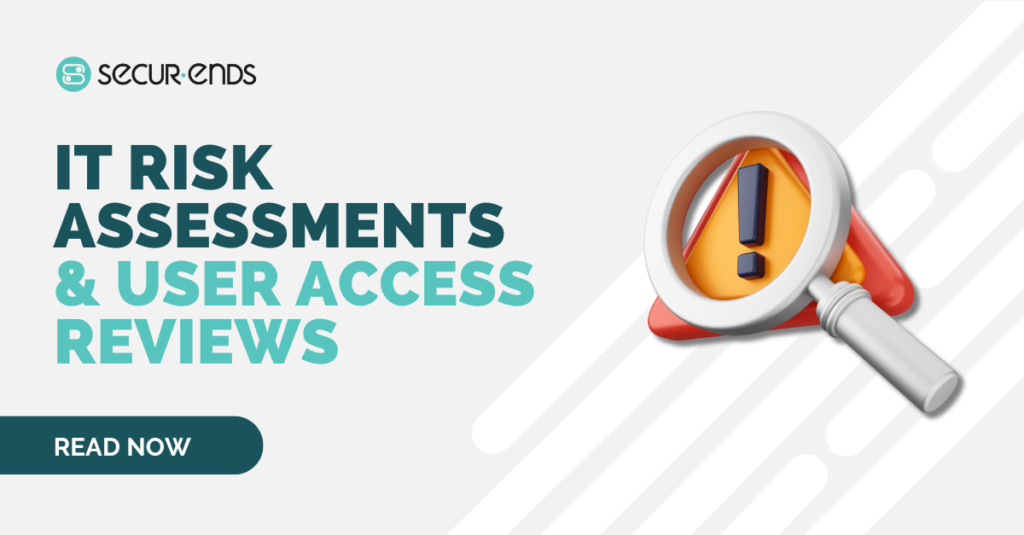Deep Dive: The Critical Link Between IT Risk Assessments & User Access Reviews
Deep Dive: The Critical Link Between IT Risk Assessments & User Access Reviews

Safeguarding sensitive data is imperative for organizations across all industries – as technology progresses, cybercriminals adapt their tactics, underscoring the need for companies to bolster their defenses against potential vulnerabilities.
Two critical measures that not only assist in maintaining compliance with standard regulations such as HIPAA, SOX, ISO, etc., but also contribute to enhancing cybersecurity posture, are IT risk assessments and user access reviews.
IT risk assessments involve a methodical process of identifying, analyzing, and evaluating potential threats and vulnerabilities that could compromise your organization’s information systems. By conducting thorough internal and external risk assessments, you can gain insights into weaknesses in your IT infrastructure and implement appropriate controls and mitigation strategies to minimize the likelihood and impact of potential risks.
User access reviews entail scrutinizing and validating the privileges granted to individuals within your network. This process ensures that employees, contractors, third-party vendors, and service accounts have only the necessary access rights required to perform their job functions. Regular user access reviews help mitigate the risk of unauthorized access, insider threats, and data breaches resulting from compromised credentials or overprovisioned accounts.
The correlation between IT risk assessments and user access reviews is undeniable. Conducting thorough risk assessments helps identify vulnerabilities, including weaknesses in user access controls. By integrating user access reviews into the risk assessment process, your IT team can identify gaps in access permissions, detect potential insider threats, and mitigate the risk of unauthorized access to critical systems and data.
SecurEnds has been working with hundreds of organizations, helping them mature their compliance and security programs. Based on years of those learnings, we recommend that your team establishes an ongoing process that encompasses the following steps:
Step 1️⃣: Planning
At the beginning of each year, designate a team responsible for conducting IT risk assessments and user access reviews. Define the scope, objectives, and timeline for the assessments, considering regulatory requirements, industry standards, and organizational priorities.
Step 2️⃣: Data Gathering
Collect relevant information about the organization’s IT infrastructure, systems, applications, and data repositories. Review documentation related to previous risk assessments and access reviews, including incident reports, security policies, and access control lists. SecurEnds CEM products make data gathering a breeze using its myriad of data ingestion methods.
Step 3️⃣: Risk Identification
Identify potential threats and vulnerabilities that could impact the confidentiality, integrity, and availability of critical assets. Consider factors such as emerging technologies, changes in business operations, and external threats when assessing risks.
Step 4️⃣: Risk Analysis
Evaluate the likelihood and potential impact of identified risks on the organization’s business objectives and operations. Prioritize risks based on their severity, likelihood of occurrence, and potential consequences, considering the effectiveness of existing controls and mitigation measures.
Step 5️⃣: Risk Mitigation
Develop and implement appropriate controls and mitigation strategies to address identified risks. This may involve implementing technical safeguards, enhancing access controls, updating security policies, or providing training and awareness programs for employees.
Step 6️⃣: User Access Reviews
Conduct thorough reviews of user access rights and permissions across all systems and applications. Verify that employees, contractors, and third-party vendors have only the necessary access privileges required to perform their job functions. Remove or adjust access rights as needed to minimize the risk of unauthorized access and data breaches.
Step 7️⃣: Documentation and Reporting
Document the findings of the IT risk assessment and user access reviews, including identified risks, mitigation strategies, and action plans. Prepare comprehensive reports for senior management and stakeholders, highlighting key findings, areas of improvement, and recommendations for enhancing cybersecurity posture.
Step 8️⃣: Monitoring and Review
Establish mechanisms for ongoing monitoring and review of IT risks and user access rights throughout the year. Regularly assess the effectiveness of implemented controls and mitigation measures and adjust strategies as necessary to address evolving threats and vulnerabilities.
In summary, to ensure the ongoing effectiveness of IT risk assessment and user access reviews, organizations can leverage comprehensive solutions like those offered by SecurEnds. SecurEnds provides tailored products designed to streamline the process of conducting user access reviews and IT risk assessments, offering organizations a holistic approach to cybersecurity management.
✍ Article by Abhi Kumar Sood